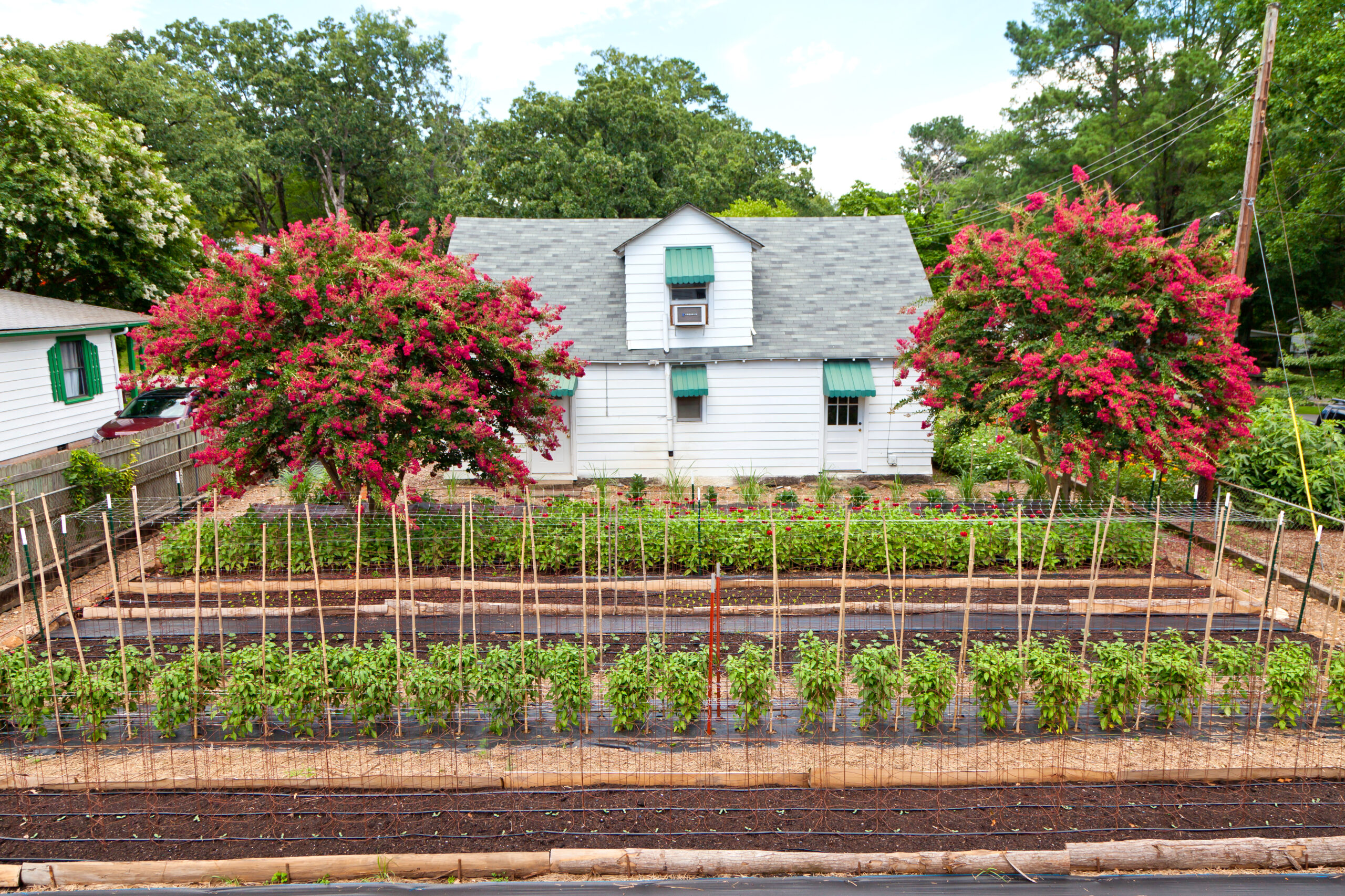As state and local government leaders struggle to effectively deal with the continued public health and economic impacts of COVID-19, communities large and small across Arkansas are struggling with food system issues. Too much in one place, not enough in another. USDA school lunches and Seamless Summer meal programs have had to switch from daily cafeteria-based food service protocols to distributing food packages available for pickup once or a couple of times a week.
Recent experiences with COVID-19 demonstrated that our local food supply chains are short and fragile. When restaurants, farmers markets, farm-to-school programs and other gate-to-plate customers like universities and corporate cafeterias went offline in a blink of an eye, it sent an economic shock throughout our state’s community networks of local and regional farmers.
“The lack of food system resiliency was experienced in many explicit ways,” Steve Luoni, director of the University of Arkansas’s Community Design Center, said. “Small farmers who supply local restaurants, schools, hospitals and the entire food away from home market — constituting 53 percent of food consumed — saw their markets evaporate overnight.”
Demand collapsed in an instant, but you can’t tell a head of lettuce to stop growing and in the case of our regional farmers, Ozark All Season found itself sitting on over a thousand heads of lettuce on hand and no market demand. Through heroic efforts by many of our local food champions, many farmers found a way to at least donate the bulk of their produce through charitable food networks, like the Arkansas Hunger Relief Alliance and/or area food banks. And, while it’s good that those fresh products were not wasted, donations don’t pay the mortgage.
Arkansas’s agriculture economy makes up 8.1 percent of our state GDP and, of that, organic production in Arkansas grew significantly from 2012 to 2017. By 2017, the number of farms selling organically produced commodities had increased from 32 farms to 69. During this time, sales of organic products increased by almost 3,000 percent, from $789,000 in 2012 to over $24 million in 2017.
In 2012, the Arkansas Department of Agriculture established a program called the Arkansas Grown initiative to support and promote local/regional food production networks. Arkansas Grown has over 900 members and local/regional direct-to-consumer food sales accounted for approximately $9.2 million in 2019.
“Procuring products from within the state spurs local economic development by engaging Arkansas farms and producers,” said Arkansas Agriculture Secretary Wes Ward.
So what can local governments do to strengthen community food systems?
As it turns out, quite a lot. In its “Cities and Circular Economy for Food” report, the Ellen MacArthur Foundation said, “Cities can trigger a shift to a better food because cities have a unique opportunity to spark a transformation towards a circular economy for food, given that 80 percent of all food is expected to be consumed in cities by 2050.”
Investments in the infrastructure of a circular economy are based on an urban planning model that understands and invests a diverse ecosystem of local/regional farmers: Products can be sold at such places as farmers markets, food hubs and direct farm sales.
“The middle agricultural supply chain infrastructure of food hubs with processing, distribution and value-added production functions are missing in Arkansas,” Luoni said. “This missing middle supply chain correlates with both resiliency deficits (fragility) and nutritional shortfalls in our food system.”
In an effort to strengthen these missing middle food-system gaps, the USDA’s Natural Resources Conservation Service recently launched the “Office of Urban Agriculture and Innovative Production” program. USDA’s Under Secretary for Farm Production and Conservation Bill Northey said, “Such projects have the potential to address important issues such as food access and education and to support innovative ways to increase local food production in urban environments.”
Reginald Jackson, the USDA’s Natural Resources Conservation Service public affairs specialist for Arkansas, advocates for a watershed approach to growing healthy regional and local food systems. “The NRCS approach is to provide technical assistance to landowners, farmers, local governments, and historically underserved minority farmers in ways that benefit the whole community and strengthens a regenerative agricultural economy for Arkansas communities.”
That sounds good, but how? Some examples of how cities, counties, and state agencies across Arkansas are cultivating stronger local food systems include:
*The city of North Little Rock runs a Community Gardens mini-grant program, which it funds out of its Community Development Block Grant budget;
*The Arkansas Agricultural Extension Service recently launched a commercial kitchen pilot program called Share Grounds in three counties;
*The Arkansas-based Wallace Food Center is hosting a variety of value chain food system coordination initiatives called the Food Systems Leadership Network;
*The Arkansas Department of Agriculture hosts a full-time Farm to School/Institution coordinator along with the Arkansas Grown specialty crops network.
“The coronavirus pandemic revealed weaknesses throughout so many of our systems, but in regard to our food system, it showed us how valuable our local food systems are,” Heather Friedrich, program manager for the University of Arkansas’s Center for Farms and Food, said. “Being able to connect with local farmers and get your food that was grown an hour or couple of hours away, compared to food that spends a couple of days in a truck with multiple points of contact between the farm and your table, is a food security issue. Our local farms play a critical role in a safe and secure food system.”
So what does all that mean for our cities and counties? As mayors and county judges are grappling with major public health concerns, they’re also facing pressures compounding from the multiplier effects of knowing that schoolchildren are still going to need food, restaurants are going to need help or go under, and the local government hotel, motel and restaurant tax base is collapsing. It’s a lot. Deep breaths.
What is the remedy? Our instinct is to look for one shiny thing to glom onto and focus on that because we only have so much bandwidth, and COVID-19 numbers are spiking, and we’re having approximately eleventy billion Zoom meetings a day, and what are we going to do about the upcoming school year, and, holy hell, this whole situation is just a mess.
But maybe, MAYBE, the silver lining here is that when systems like these break down, you see them a little differently and things you didn’t notice before become more apparent, as is the case with our local food systems.
What are the barriers for local governments? For municipalities, friction with zoning issues. For counties, friction with annexation issues. How is land valued and how do we prioritize valuation of soil conservation investments for both landowners and our local governments?
The Cornell University Small Farms Guide to Urban Farming says, “Until recently, city codes, zoning laws, and other regulations have largely ignored urban agriculture. However, these codes and regulations can intentionally and unintentionally regulate urban farming activities in a myriad of ways, such as by regulating the construction of structures, including chicken coops or greenhouses, the ability to keep livestock, gain access to public lands and municipal facilities, transport and distribute urban grown food and so on.”
According to the American Planning Association, “Public interest in locally grown food, coupled with an awareness of the positive environmental, social, and economic impacts of agricultural uses on urban areas, has inspired many city residents to pursue small-scale agricultural activities on both private and public lands. As the community gardening and urban agriculture movements gain popularity and the benefits become more apparent, many local governments have adopted policies and regulations that sanction or support community gardens and urban farming.”
Agriculture Secretary Ward added, “In Arkansas, we see schools, institutions, agencies, and child care facilities spending around 15 percent of their food budget on local food. The benefits can extend beyond economics to create a stable market for local products, increase participation in meal programs, and increase community awareness of local farming and food systems.”
The American Planning Association has a searchable resources page that provides “background, policy guidance, and examples of comprehensive plans and zoning ordinances that address urban agriculture from across the country.”
So then, we find ourselves at a moment in time where we can clearly see gaps in our food system that may not have been very clear before, and perhaps the silver lining in this public health emergency is that we have an opportunity to think, talk and plan for ways in which our cities, counties, communities and neighborhoods can build stronger local food systems that are strong enough to withstand system shocks and resilient enough to not just hold up in an emergency, but actively cultivate stronger local and regional food economies in Arkansas.
Melissa Terry is a food policy researcher in the University of Arkansas’s Agricultural Education Master’s Program.



